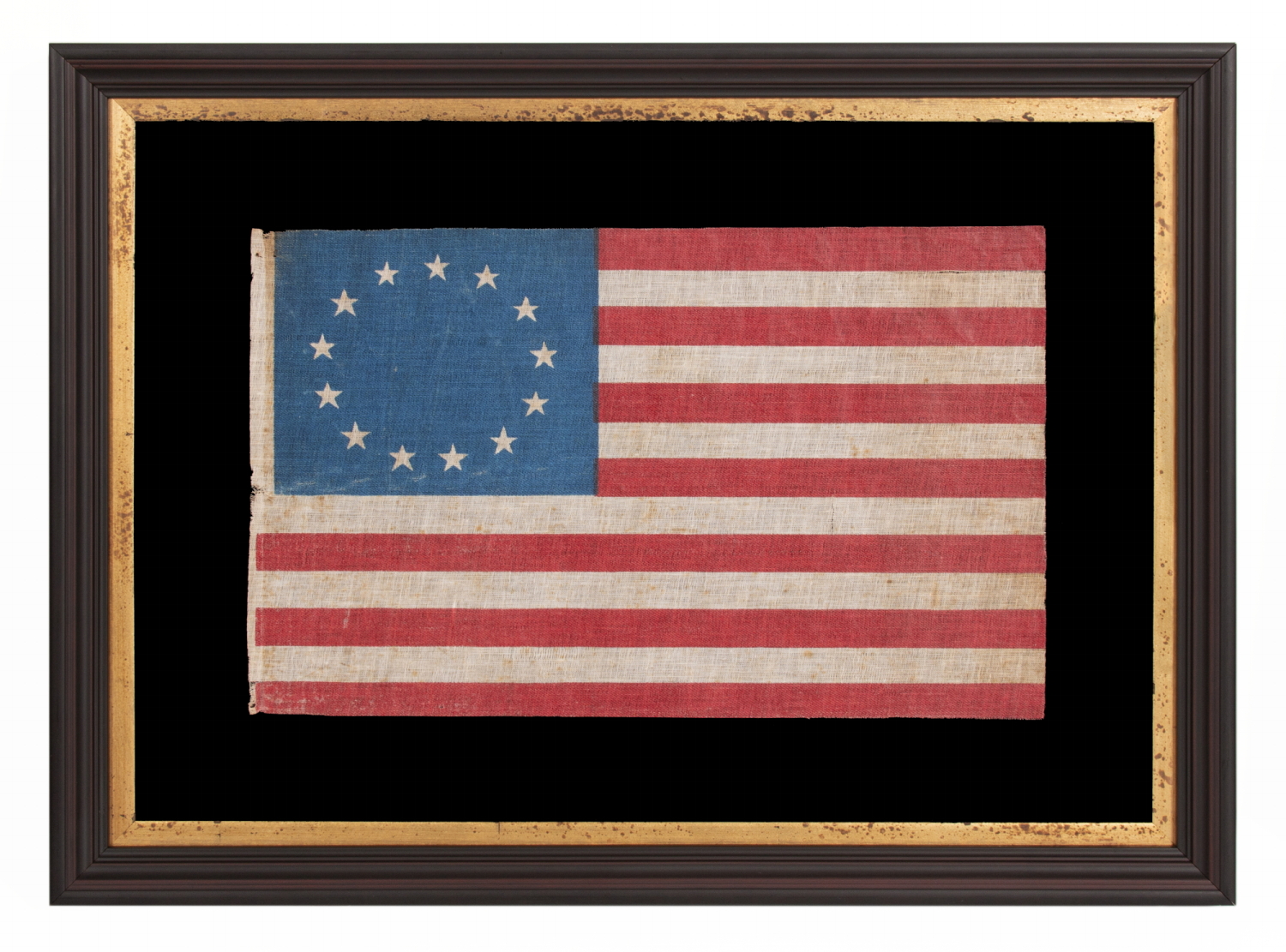
| |
13 STAR ANTIQUE AMERICAN PARADE FLAG WITH A SINGLE WREATH OF STARS REMINISCENT OF THE BETSY ROSS PATTERN, BUT RENDERED AS MORE OF AN OVAL, THE ONLY EXAMPLE OF THIS EXACT VARIETY THAT I HAVE EVER ENCOUNTERED, MADE circa 1890-WWI (U.S. INVOLVEMENT 1917-18) |
|
| Available: |
Sold |
| Frame Size (H x L): |
19.25" x 26" |
| Flag Size (H x L): |
11" x 17.75" |
|
| Description....: |
|
13 star antique American parade flag, printed on coarse, glazed cotton. Note the crude and interesting weave of the fabric, which is very attractive from an early textile perspective and serves to effectively communicate the age of the textile from a visual perspective. Likely made in the period between roughly 1890 and WWI, the stars are arranged in a single wreath that falls somewhere between the circular design often attributed to Betsy Ross and the oval pattern associated with Major Pierre L'Enfant, designer of the City of Washington, who illustrated such a flag on a diploma he created in 1783 for members of the Society of the Cincinnati, an elite fraternal order for commissioned, Revolutionary War officers.
Whether the shape of the wreath was intentional or not remains unknown, but the important facts to remember with regard to this particular flag is that it is (1) rare, (2) early among known parade flags in either the Betsy Ross or L’Enfant configurations, (3) if it truly illustrates the L’Enfant design, it is rare indeed, as flags in this pattern are all but unknown. Whatever the case may be, it is a beautiful example, with great cornflower blue and scarlet colors, great texture, attractive wear and patina from obvious use. As someone who has owned more than 1,000 antique flags with 13 stars, viewed and studied many others, and who has owned literally thousands of early American parade flags, I can say that I have never seen this particular variety before, and find it equally compelling for both for its uniqueness and its presentation.
13 star flags have been flown throughout our nation’s history for a variety of purposes. They were hoisted at patriotic events, including Lafayette’s visit in 1824-25, the celebration of the nation’s centennial in 1876, and the sesquicentennial in 1926. They were displayed during the Civil War, to reference past struggles for American liberty, and were used by 19th century politicians while campaigning for the same reason. The U.S. Navy used the 13 star count on small boats until 1916, because it was easier to discern fewer stars at a distance on a small flag. Commercial flag-makers mirrored this practice and some private ships flew 13 star flags during the same period as the Navy. The use of yachting ensigns with a wreath of 13 stars, surrounding a fouled anchor, which allowed pleasure boats to bypass customs between 1848 and 1980, persists today without an official purpose.
In spite of what most Americans were taught in grammar school about Betsy Ross having created the first American flag, and that it had a circular wreath of 5-pointed stars, there is no way to prove the claim. No colonial examples have survived in this star pattern. In fact, I have encountered just a couple of examples of flags with the Betsy Ross configuration that I am convinced pre-date the last decade of the 19th century. In spite of this fact, due to the popularity and familiarity of the Ross pattern, flags in this design are beloved by many Americans, which makes them desirable in the marketplace for both antique and vintage flags.
Mounting: The flag was mounted and framed in-house. For 25 years we have maintained our own specialized department for this purpose and our lead conservator holds a master's degree in textile conservation from one of the nation’s top programs. We take great care in the mounting and preservation of flags and related textiles and have preserved thousands of examples.
The mount was placed in a step-down profile molding with a surface that is a very dark brown in color, nearly black, with reddish undertones and highlights, to which a hand-gilded and distressed Italian molding was added as a liner. The background is 100% cotton twill, black in color, that has been washed and treated for colorfastness. Spacers keep the textile away from the glazing, which is U.V. protective glass. Feel free to contact us for more details.
Condition: There is minor fabric loss along the white area of the hoist end, where the flag was once affixed to its original wooden staff, and there is minor to modest soiling. There is a minor separation between the 1st and 2nd stripes, toward the fly end. There is extremely minor fading of the red pigment and very minor pigment loss or misprinting in the red and blue pigments. Many of my clients prefer early flags to show their age and history of use. |
|
|
|
| Collector Level: |
Advanced Collectors and the Person with Everything |
|
| Flag Type: |
Parade flag |
|
| Star Count: |
13 |
|
| Earliest Date of Origin: |
1890 |
|
| Latest Date of Origin: |
1918 |
|
| State/Affiliation: |
13 Original Colonies |
|
| War Association: |
|
|
| Price: |
SOLD |
|
| |
Views: 17 |
|
|
|

